i lJ ECONOMICS OF PORTS 8U ,a ...
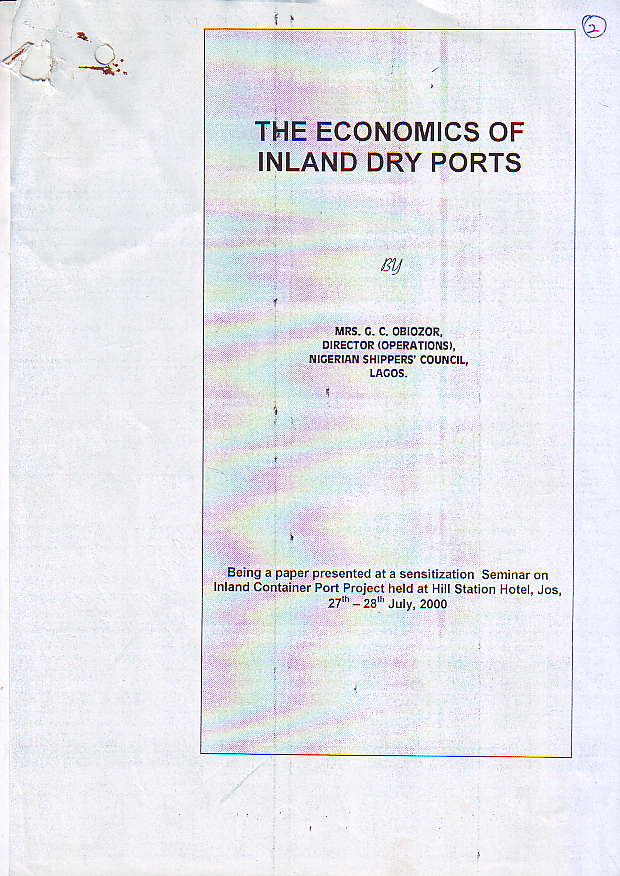
i
lJ
ECONOMICS
OF
PORTS
8U
,a
'
,..:..
" ::f s""",,.1r,il,"H"J#":l
ff ::';ltiil::,ff
lTtr,.]:,,
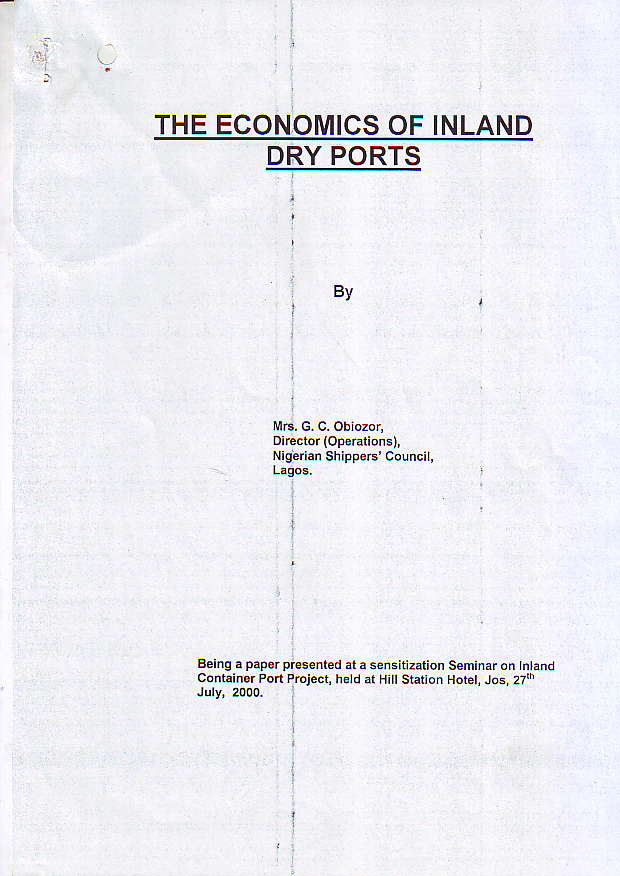
THE ECONOMICS
OF INLAND
DRY PORTS
ey
Ber.s a papsr pi6enred ai a senEidz
conbinr Pon P6je.t, hdd ar Hir s
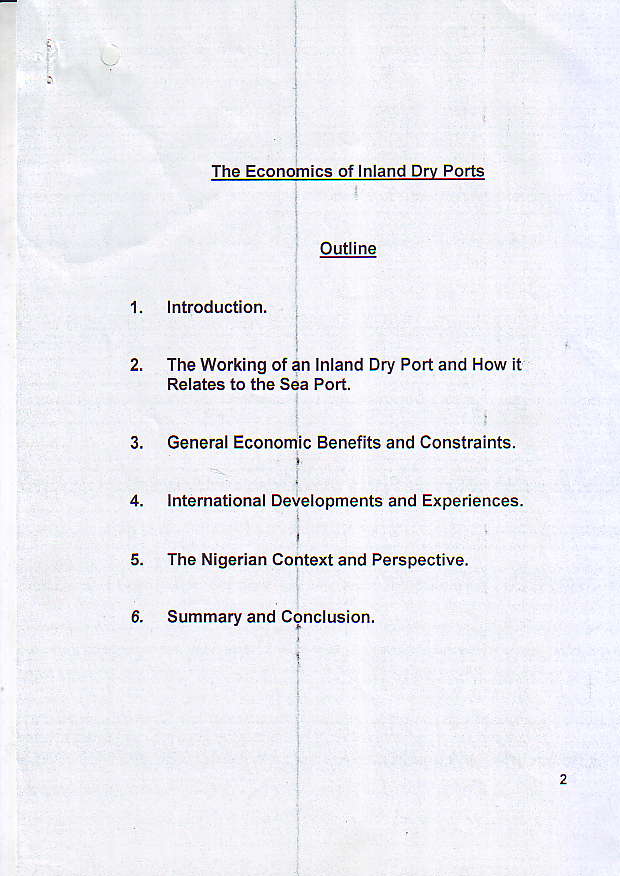
The Economic ol lnland
Dru Ports
S!!i.Ee
2. TheWo*ing
olan Inland
Dry
Port
and How
it
Relates to the Sea Port,
3. GsneralEconodic
BenefitsandConstraints.
4. lntomationalDeveloDmentsandExoerlences.
5. The Nig€rian Cohlextand
Perspective.
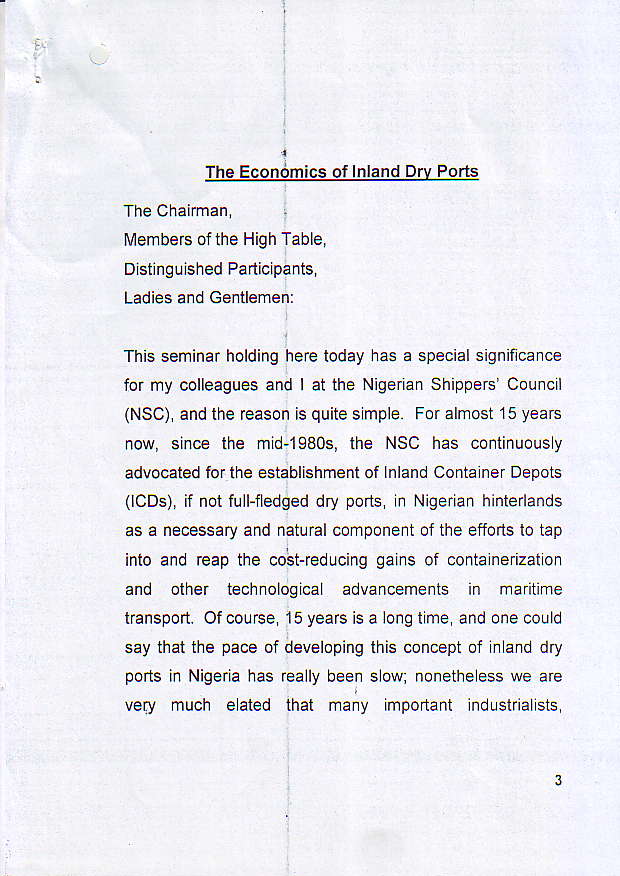
The Economics
oflnland
Drv Ports
Members
ol ihe High
Table
Disiing!
shed
Participants
Ladies
ard Certlemen:
This senrinar
holding
here
loday
has a special
signincance
Jor nry colleagues
and I at the Nigenan
shippers
coufcl
(NSC)
and
the reason
is quite
smpl€ Foralmosi
15 years
now, sin€ the mid'1980s,
the NSC has co inuousy
advocated
iorlhe establishmenr
of Lnland
contalner
Depois
(lCDs),
if not full-fLedged
dry ports n Nigedan
hintedands
as a necessary
and natural
component
oi the effons
lo tap
inlo ard reap the cosfreducing
gains
or containe
zaion
and olher technologcal
advancem€.ts in mantrme
transport.
Ofcolrse
15 yeals
is a long
I me andonecoud
say that the pace
of developing
this concept
ol I and dry
polG ii Nigeria
has rea
ly been
sou nonetheess
we are
very much e ated thal rnany nrpoi(ani
lnduslria
sts
3
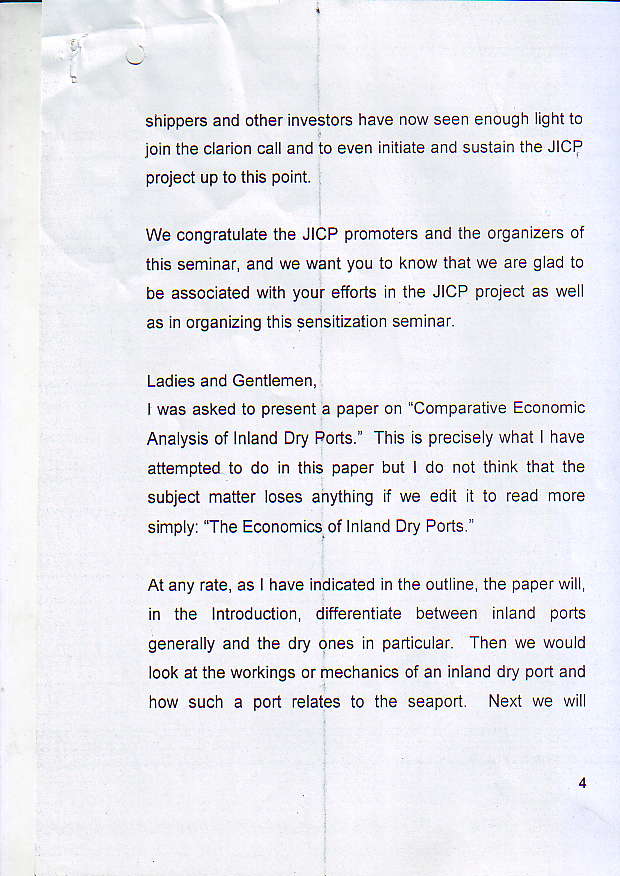
shippers
and otherinvestors
have
now
join lhe clarion
calland
to even
innate
We cong|alulaie
ihe JICP
promoteB
and the organzers
or
this semlnar,
and we want
you io know
that
we are g ad to
be assoclated
wllh your efforts
'r the JlcP proiecl
as we
as in organizing
th ssenstizallon
seminar.
Ladies
aid Genilemen,
I was asked
to present
a paper
of Compa.ative
Economlc
Anaysis
of Inland
Dry
Porls.'
This
is pr€cisey whal
l have
aitempied
lo do in this paper
but I do not think that the
subjecr
mattef
loses
an),lhing
if we edit t to read more
sinply:'The
Economics
oflnand
Dry Porls.
Atafy rate,
as lhave indicaied
in ihe ouiine the paperwil
in the Lntroduclon
differenilale
between
inland ports
generally
and ihe dry ones n pad:cular.
Then
we would
iook
ai the workings
ormechanics
oian inland
dry pofi and
how such a porl rclates
to the seapori. Next we wl
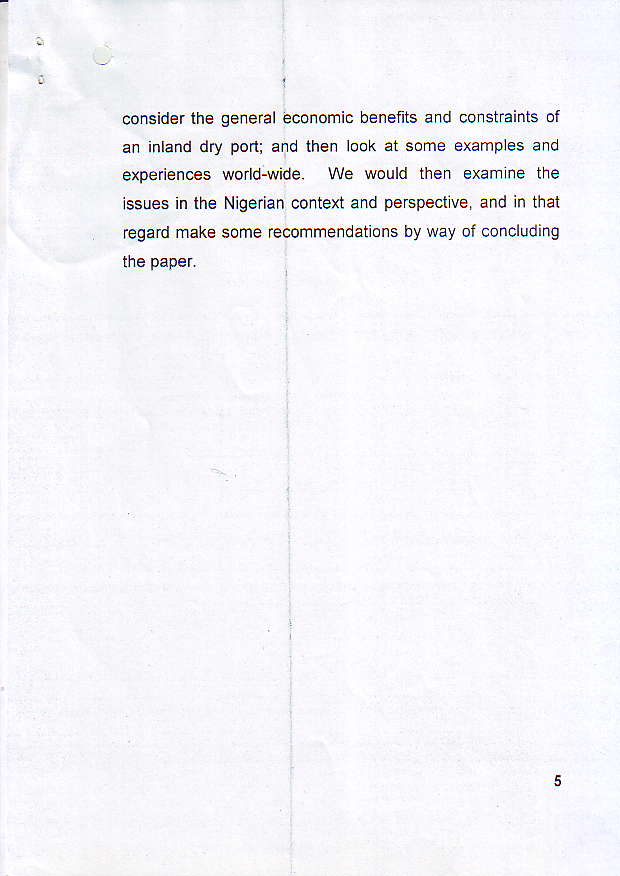
consider
the general
6conomic
benents
and constraints
of
an inland
dry po( afd then look at some examples
afd
oxperien@s
wo d-wide. We would ihen exarnlne
the
lssues
in the Nigeian
context
and peBpeclive,
and in that
r€gaftj make
some
recomrnendations
by way oI concluding
5
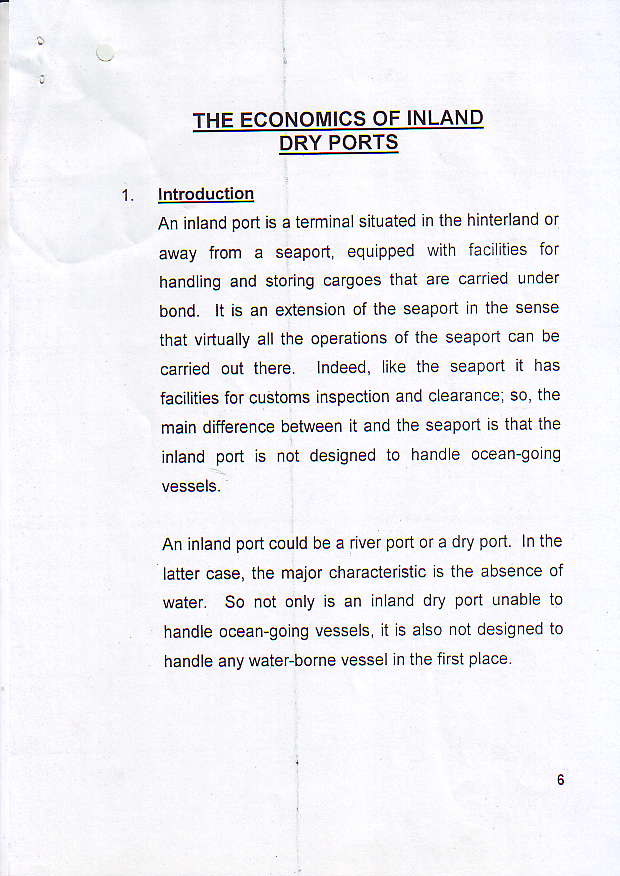
THE ECONOMICS
OF INLAND
DRY PORTS
lntroduction
An inland
pod
is a termfalsitlated
in the hinle
andor
away irom a seapori equpped
witlr facililes tor
hardLlng
and storing
cargoes
that are cared under
bond. lt is an extension
of the seapoft
n the sense
that virluaLly
all the operations
of the seaporl
can be
caried out ihere lndeed,
ike ihe seaporl has
facLliiies
ior clsioms
inspeciion
and cLearance
so, tne
main
difference
beiween
it and the seaporl
Ls
ihat the
inland pod ls not designed
to hafde ocean
gofg
An jnland
podcould
be a ive. port
or a dry port Lnthe
Latter
case,
the major
chaBcterstic
s the absence
oi
waier. so not only is an nand dry pod unable
to
handle
ocean
gong vessels
lt s a so not desgned
to
handle
any
waierborne
vessel
n thetustpLace
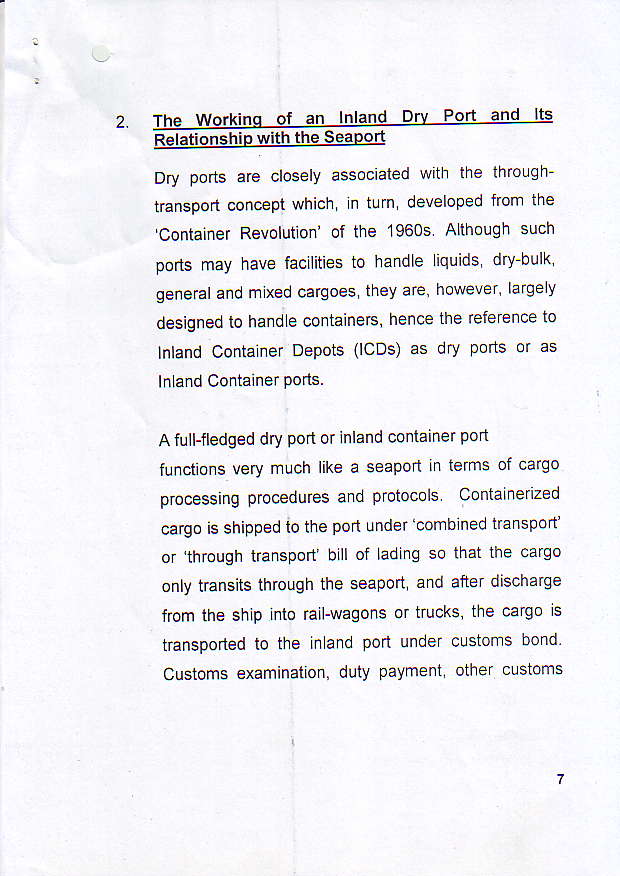
2.
The workinq of an lnland Dru Port and lts
Relationship
with the seaporr
Dry poirs are closelv
associaled
with the lhrough
transport
con@pt
which nturn developed
irom the
'Container
Revoluilon'
of ihe 1960s ALthough
such
ports may hav€ faciliti€s to handle iquids drv bulk.
gereral
ard mlxed
carqoes
thev
are.
however,
Ergev
designed
to handLe
cofiainers,
hence
ihe relerence
ro
lnland
Conialtrer
Depots
(lCDs)
as dry poi6 or as
InLand
Coniainer
Pods.
Afull-iledg€d
dry pod of lnland
container
pon
funcirons
very rnlch like a seapod
in ietms of cargo
prccessingproceduresandproiocols
ConiaLnenzed
cargo
is shipped
lo the port
under'combined
transport
or'through
transport
bill of Lading
so lhat the cargo
only transiis
thrcugh
the seaport
and aiter
discharg€
from the shlp iito €il-wagons or trucks ihe caqo rs
iransported
to ihe iiand pon under
customs
bond
LJsLoms
eYrminal.ol.
dLb orr'n"r' otre ' sofs
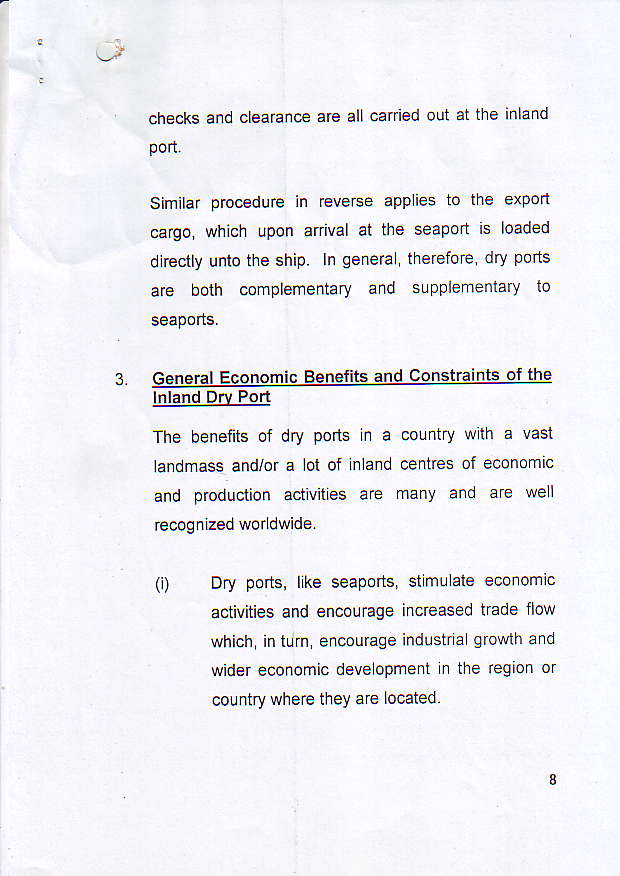
checks
and clearance
are alL
cairied
out at ihe inland
Similar
pro@dure
in reve6e applies
to lhe expon
cargo which upon arival at ihe seapoft
is loaded
dl€ctly unlo
ihe ship. In genera therefo€, dry po.ts
afe both complernentary
and supplemenlary
to
3.
GeneratEconomic
Benefits
and Constraints
of the
lnland
Drv Port
The benefiis
oi dry ports i a
landmass
and/or
a ot of nland
and production
acilvltes
are
(i)
Dry po'is, lke seapoiG,
stmlale economic
activities
and encolrage
increased
irade
now
which in lurn encourage
indlstra gro\\4lh
and
wider
€conomic deveopmeni
I the region
or
countrywhere
they
are Located
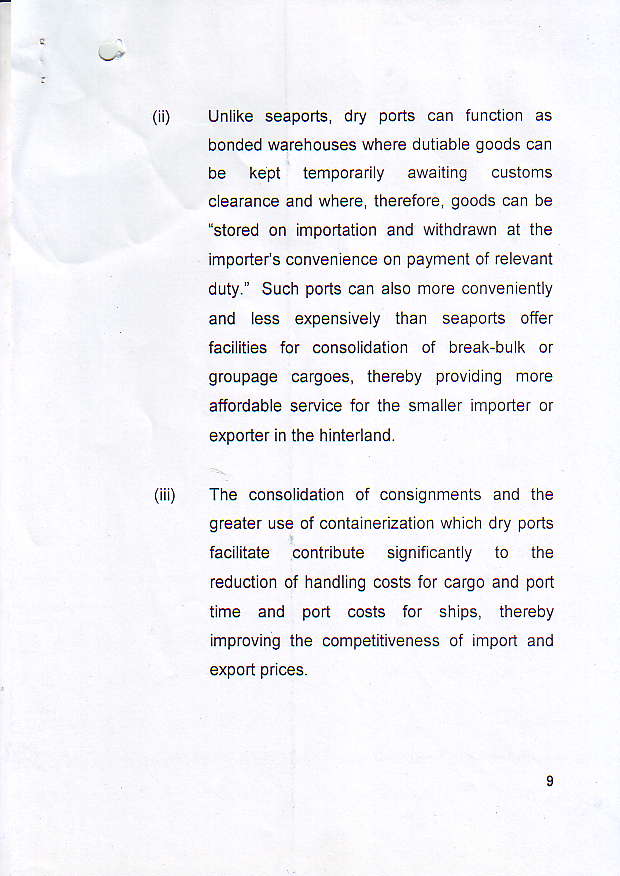
(i)
Unlike
seaports
dry pons can iuncton as
bonded
warehouses
whee duuabe
goods
caf
be kepl temporariy awa
trng customs
cearance
and where
lherefore
goods
can be
'stored
on importation
and withdrawn
at the
impoders
conven
ence
on payment
ot relevanl
duty. Such
pons
can aiso
more
conven
ently
and Less expensivey
thaf seapor'ts
offer
faciities
for mnsolidaiof oi break
bu k or
grolpage cargoes,
ihereby provdlng
more
aifordable
service
ior the smaler importer
or
exporter
in the hinlerland
(ii)
The consolidalon
of consgnments
and ihe
greater
use of conla
nerizalon
whlclr
dry porls
facilitate contribute signifcant
y io the
redrcloi of handliig costs
for calgo and porr
tme and porl cosls for sh ps, thereby
improving
the competitiveness
of impod and
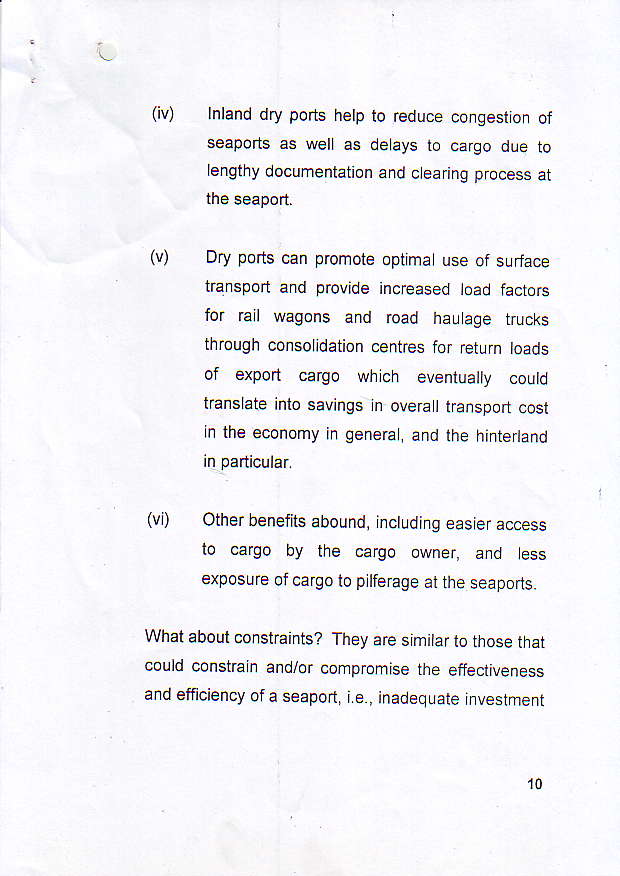
hland dry ports hetp to reduce
congeslion
seapons
as wel as deays ro cargo du-A
eng$y documentation
and cearing
process
(v)
Dry poirs
can ponrote
optima
use or surface
transport
and provide
increased
toad facroB
for ral wagons and road hauage trucks
flrrough
consotdation
centres
for return
toads
oi expori cargo wh ch evenluaily
coutd
lransate
inlo savings
. overa
I lrarspori
cosl
I the economy
in genea and lhe hintedand
Otherben€iits
abound,
ifctudins
easier
access
lo cargo by tlre cargo owner, and ess
exposure
dcargoto p tferage
ar the seaports.
Whalaboul
constraints?
They
are similarlo
those
thai
could
consirain
and/or
compromise
ihe effecriveoess
and
efiiciency
ofa seaport
ie , inadequate
invest.nent
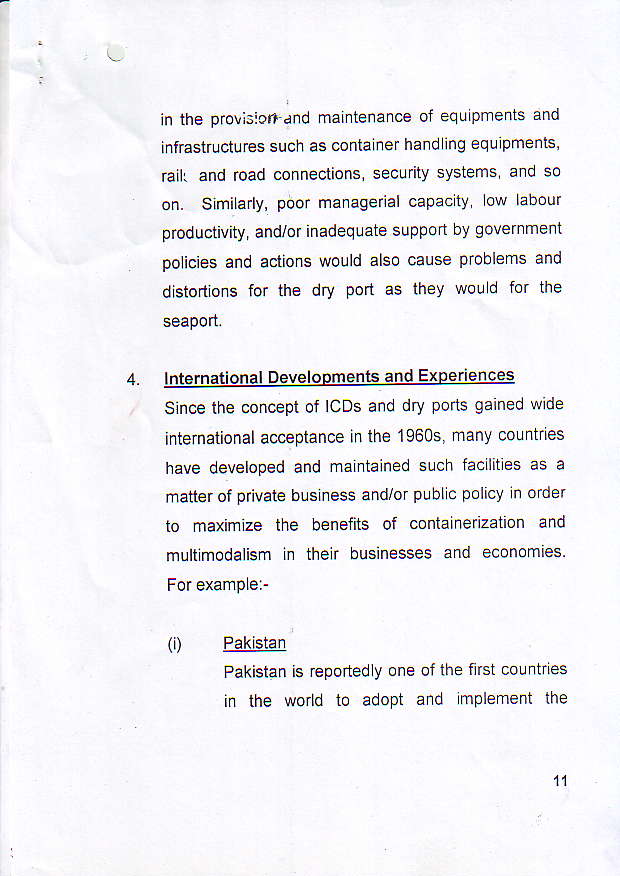
in the prolisltn
ard maLntenan@
ol equpments
and
infastruci!€ssuch
as @niainer
hand
ing eq! pments,
rail and road @nneclions,
security
svstems
ano s0
on. SimiLa
y, poor manageial
capacly ow labour
produciivity
and/or
inadeqlai-c
suppod
bv government
policies
and aclions
would
also cause
problems
and
distodons
ior ihe dry pod as lhev wold for the
lnte.national
Develoomenls
and ExPeriences
Since
the concept
ot lCDs and dry ports
garned
wrde
international
acceplance
in lhe 1960s,
man\\'
countrLes
have developed
and maintained
slch facliues
as a
matler
ot private
blsLress
and/or
publc policv
n order
io maximize
the benefiis
of conlainerlzaiion
and
mulilmodalism
ii their businesses
and economies
Pakislan
is reported
Y one
in the wond 10 adoPt
11

concept
oi lcDs when in 1964 it starled
work
on such a iacilrly in Lahore. owned and
operated
by the Pakistan
Raitways.
lhe Latrore
ICD was opened n 1974 afd by j991 rs
conraner
tmfiic
is said
lo have
grown
ro over
16,000
tEUs.
very impodanfly,
it is repoded thal the
esiablishmeni
oithe ICD has hetped
io clrange
lne corcepl
ol lransporl,
tn both physrcat
and
organizationalterms
in pakistan
and has trad
a proround
beneticia
effect
on the irading
and
industiat
activjiies
of the country. tt is also
sard
lo have
aided
and ercouraged
the parlia
rclocation
of activities
from
parls
ofth€ coastal
areas
oithe courtry
1o
the hintertand
which,
in
turn rras
led to decreasifg
transpon
costs
ard
reduced
pori congesiion. Furthermore
the
ICD is said to have enhanced the
atiracliveness
of indusfat setflemenis
I rhe
12
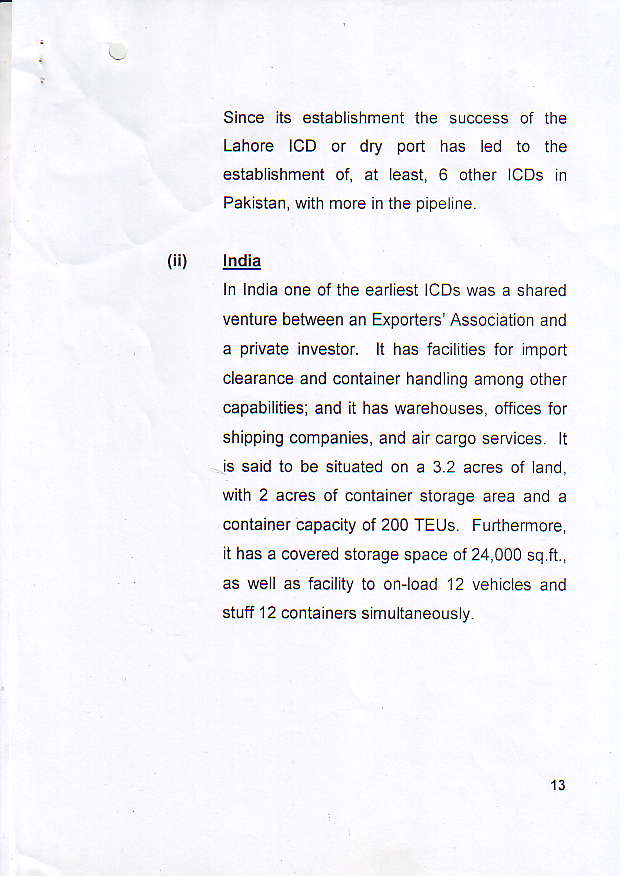
Since lts eslablshment
lhe success
oi the
Lahore ICD or dry port has led io the
€stabishment ol at Least,
6 olher CDs if
Pakstan,
with
more
in the pipelne
(i4
!-!die
In Indla
one oi the eadest
lCDs
was a shared
venlu€ bet\\deen
an Exporterc'
Assoc
ation
and
a prvate
investor.
ll has Jaciliies
ior mport
clea€nce and coniainer
hand
ing amons
other
capablitiesj
and it has warehouses,
otrices
ior
shipping
companies,
and air cargo
seruices
lt
is said to be situated
on a 3.2 acres
of and,
wilh 2 acres
of conlainer
slorage
area afd a
container
capacity
of 200
TEUs. Furthemore
t has
a covered
storage
spa@
ot24,000
sq ft.
as welas facllity
to on]oad 12 vehices
and
stutr
i2 containeF
s muiianeous
y
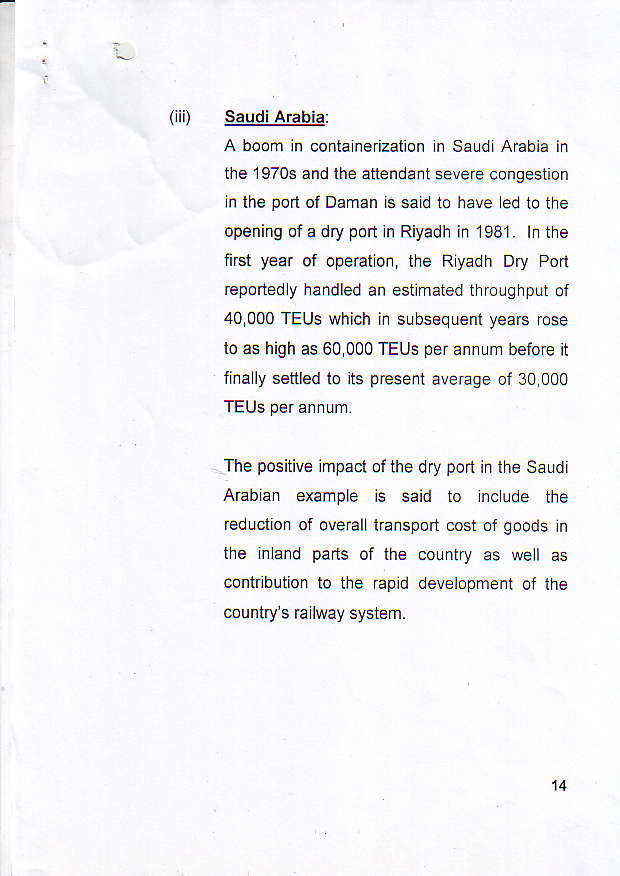
(ii)
A boom
in conianerizaiion
n SaudiArabia
in
the 1970s
and
the attendant
severe
congestion
n the po.t of Daman
is said
to have ed to the
openins
oi a dry port
in Riyadh
in 1961. In the
lirst year of operalor,
tlre Ryadh Dry Port
repoited
y handled
an estimated
throughput
oi
40 000 TEUS
which
in subsequenl
years
rose
lo as high
as 60 000
TEUS
per a.fum beforc
it
iiialy seitled
lo its prcsent
ave.age
of 30 000
The positive
impac-l
ofthe dry port in lhe Saudi
AEbian exampLe
ls said to ncude the
eduction
of overal
lrafspoir
cost oi goods n
the fland parts of the country
as well as
contribuiion
lo the rapid
development
ol lhe
country's
ra lway
system.
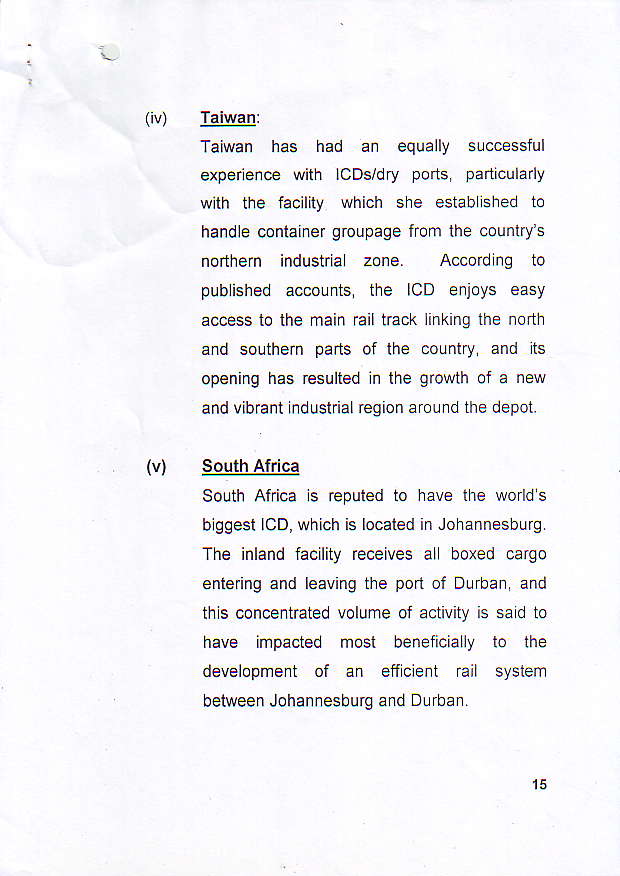
Iejva!:
Taiwan has had an equally successiul
experlen@
wilh LCDs/dry
ports partrculadt
with the facilily which she estab shed to
handle
containe.
grcupase
from the counlrys
nodhern industria zone.
published
accolnts the ICD eijoys easy
access
to the main
rail track
linking
the nodh
and solthem pats of lhe counlry and lis
opening
has esulied in lhe growth
oi a new
and
vibrant
nduslriaLregion
around
the depot.
(v)
South
Africa s repuled
io have lhe worlds
bggesl
lCD,
which
is localed
in Johannesburg
The inland
facility
receives
aL bored cargo
ente.ing
and leaving
ihe port of Durbaf and
th s concentrated
volume
oi activity
is sad to
have irnpacted
most beneliciaLly
to lhe
development
of an etrclert raiL syslenr
between
Joharnesburg
and Durban.
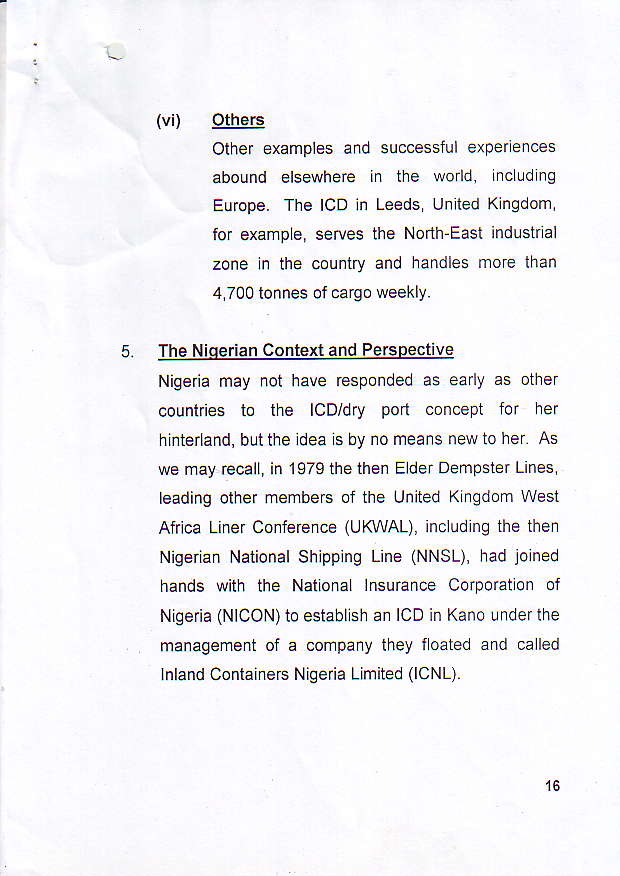
(vi)
Olher examples
and successlul
experen@s
abound elsewhere
in the world. ncudng
Europe.
The ICD ln Leeds United
Kngdom,
fof exampe,
serves
the Nofth
Easi indusirlai
zone n the couniry
and lrandles
more lhan
4 700lonnes
of cargo
weekly.
a. The Niderian
Context
and PersDective
Nigeria
may not have responded
as early as other
counl es to lhe lcD/dry pod concept tor her
hi'rtedand,
butthe
ldea s by io means
newto
her. As
we may recalL,
in 1979
the then
Elder
Dempster
Lrnes
leading
olher
menbeB ol ihe United
K ngdom
wesl
Airlca
Linef
Cofference
(UKWAL),
:ncluding
the then
Niserian
National
Shlpping
Line (NNSL),
lrad jolned
hands wilh the NatioML
lnsurance
Corporauon
oi
Nigeria
(NICON)io
esiablish
ai ICD
in Kano
underlhe
managemeni
of a cornpany
they foated and caled
Lnland
Conlainers
Nigeria
Limited
(lcNL).
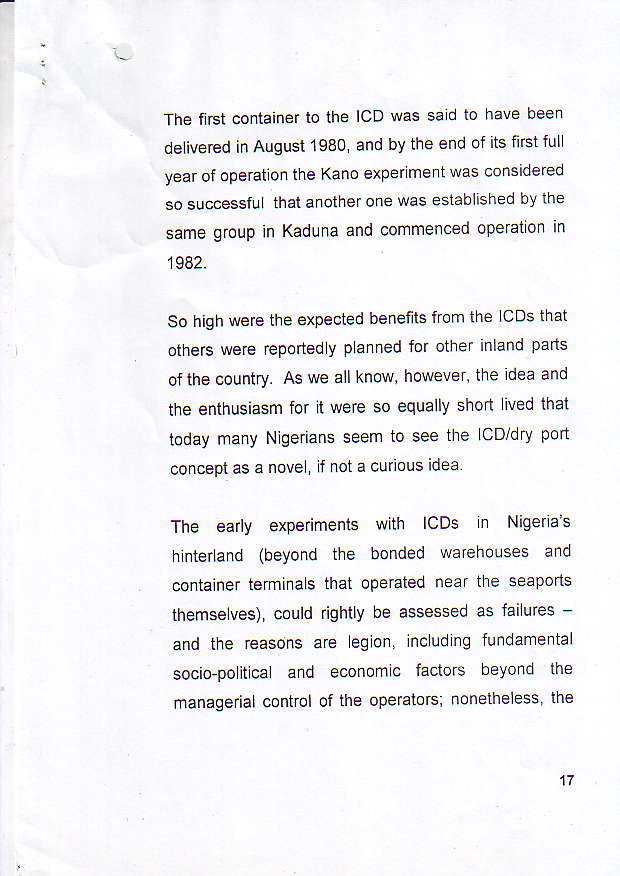
The nd container
to the ICD was sa d lo have been
de ive€d inAugust
1980,
and bv the end of iis fi6ttul
year of operailon
lhe Kano
experment
was consKereo
so successfuL
thatanothefone
was established
bylhe
same
group
!n Kaduna
and cornrnen€d
ope'alon
In
1982.
So high
were the expecled
benefils
from the CDs lhat
oihe6 we€ repoired
y pLanned
ior otlrer
inland
parls
oithe couniry.
As we allknow,
however,
the idea and
tlre enthusiasm
ior it werc so equallv
shorr ived
thal
today
rnany
Nlgerians
seem
to see the LCD/dry
pod
corcept
as a rcve i noi a curjous
idea
The early experiments
with lCDs I Nigerias
hlnt€dand (beyond
ihe bonded wareholses
ano
coiiainer
terminaLs
ihai operaied
near the seapons
themseves),
could
righlly
be assessed
as iaiu€s
and the rcasons
are egon, lncudng tundamental
socio
poitlca and emnomc factors bevond the
managerial
control
of the opefaioF;
nonelheless
tne
17

need lor, and the potenual
benefls oI such
invesiments
l. a country lke Ngeria reman
lfassaiable
in our v ew
To our mifd aso, al ihe general
or lheoreiical
benelits
oi CDs/dry
porls
which
we idenlfied
earlier
in
section
3 of ihis paper
are appicabe
lo N geria,
and
so too arc some
ofthe €suls hgh iqhted
n seclion
4
From thls perspective
lherefore,
ii s necessary
to
consider
some
ofihe bas
c conditions
we need
here I
Nigera
to overcome
and overium
the faiLres
of the
The development
and nanagemeni
of nland
dry 0r contaner
ports llave l0 be taken as
management
ofseapons
as nalonaleconom
c
and
transport
nlrastructures.
(D
The ralsyslem
would
need
io be modem
zed,
enended and genera
y positoned
lo pay its
r3
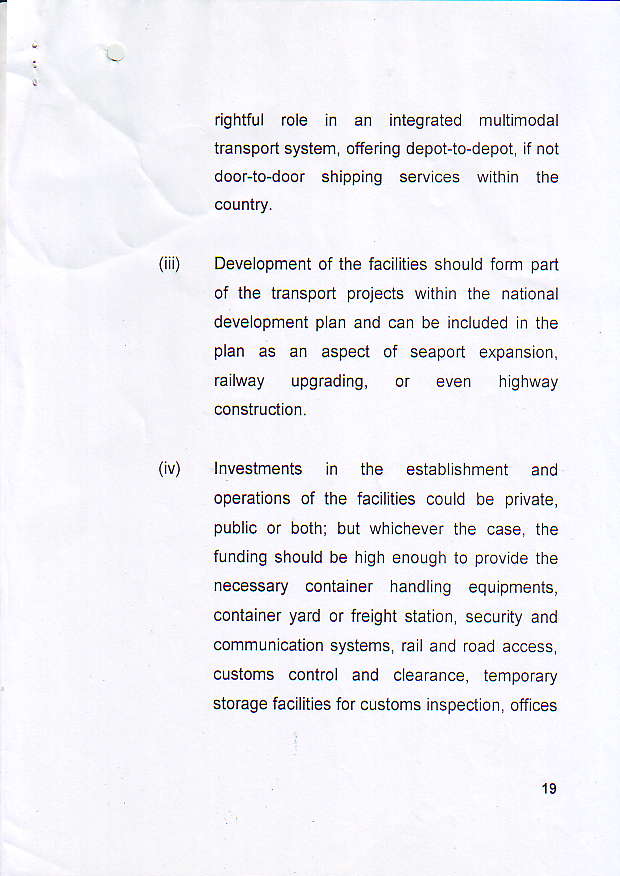
ighttul role if af inlegrated multimodal
transporl
sysien ofie ng deporto-depot
if.ot
dooFto-door
shipping setuces withln lhe
(iiD
D€velopment
of the faciiues
should
fom pari
oi the transpoi(
pojecis wthin the national
deveopnreni
paf and can be included
n the
plan as an aspecl or seapod expansion,
(iv)
Investments
ln the estab
shment and
ope|ations
oi the iaclllties
could be privale,
public
or both; bui whlchever
tlre case the
funding
should
be h 9h enough
lo provde
the
necessary
container
handlng equlpmenls,
container
yad or freight
stauof securlty
and
omnruncation
sysiems
ra I ard road
access
custorns
mnlrol and cearai@. temporary
siorage
taciliues
Jor
cusioms
inspect
on. olf ces
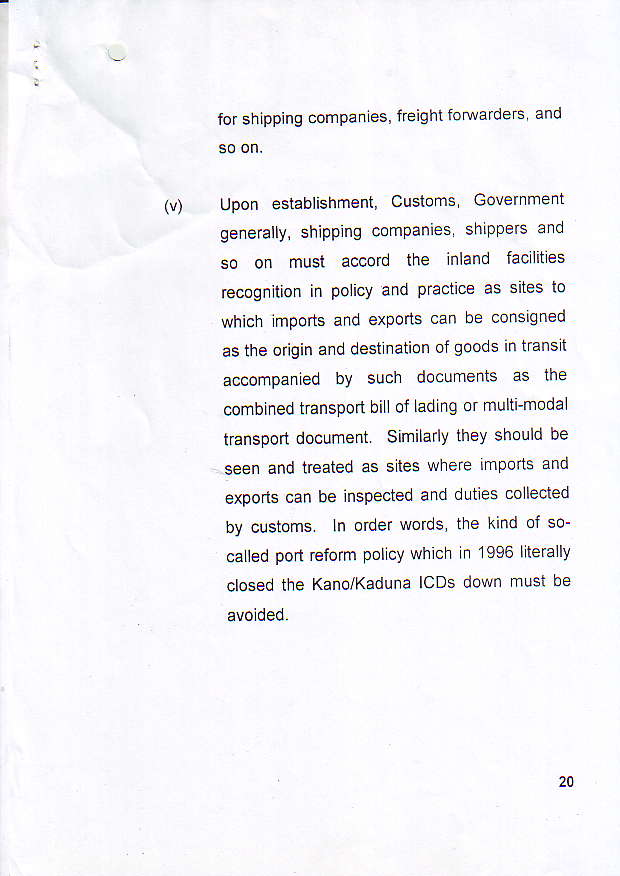
shipping
companies,
freight
roNardeG and
( " )
Upon establishmeni,
customs Governrnent
geierally,
shipping
companres
snrppers
afa
so on must accod lhe inland facliues
recogfllion
in policy
and practce
as sftes
to
which
lmporls
and expods
can be consisned
as the origin
and
desilnation
ol goods
in transl
accomPanied
by such documents
as the
combined
tBnspoft
biLl
ol Lading
or multi-modal
i.anspori
document
Similarly
ihey should
be
seen
and t@aied
as stes where
imports
and
€xporls can be inspecied
and duties
collecled
by customs Ln order
words,
the kind of so_
caLled
pod €fom pol
cy whiclr n I 996 | terally
closed
the Kano/Kaduna
lcDs down
musi be
20
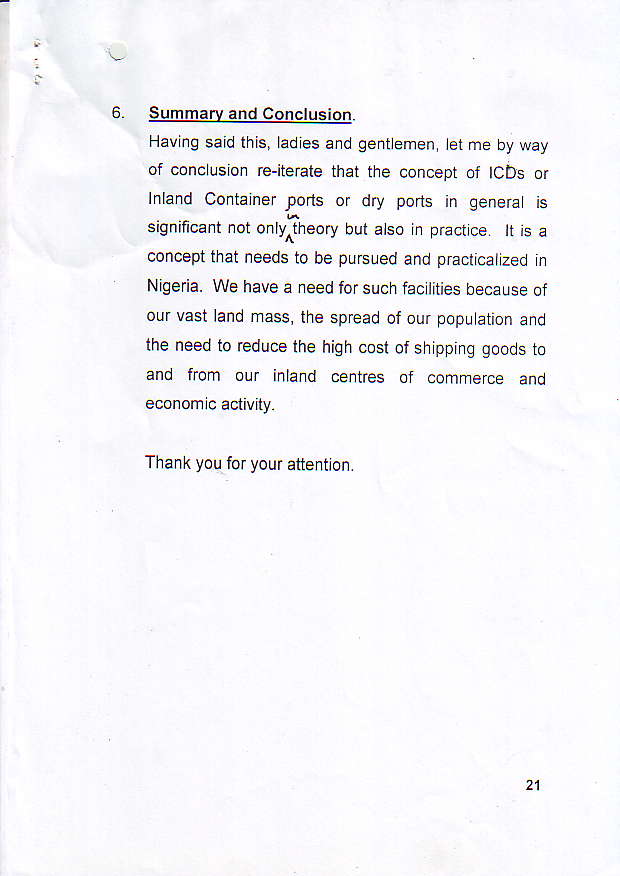
6
Summaru
and Conc,usion.
Havng
said
this,
ladies
afd genuemen
et me by way
of onclsiof e-iterale
ihat the concept
oi tcbs or
Inland
Coniarner
lorts or dry poris in genera is
crgnrqca.t
ro o y^u
eory bul rlso . orcc - t, ,, .
concept
that needs
to be pursled
and practicalzeo
I
Nigeria.
We have
a feed forsuch
faciities
because
ot
ou. vast tand
mass,
lhe sprcad
of our popu
ation
and
lhe n,Aed
io reduce
lhe hish
cosl oi slripping
goods
to
and rrom our inland certres oi commerce
driu
Thank
you for your adentron
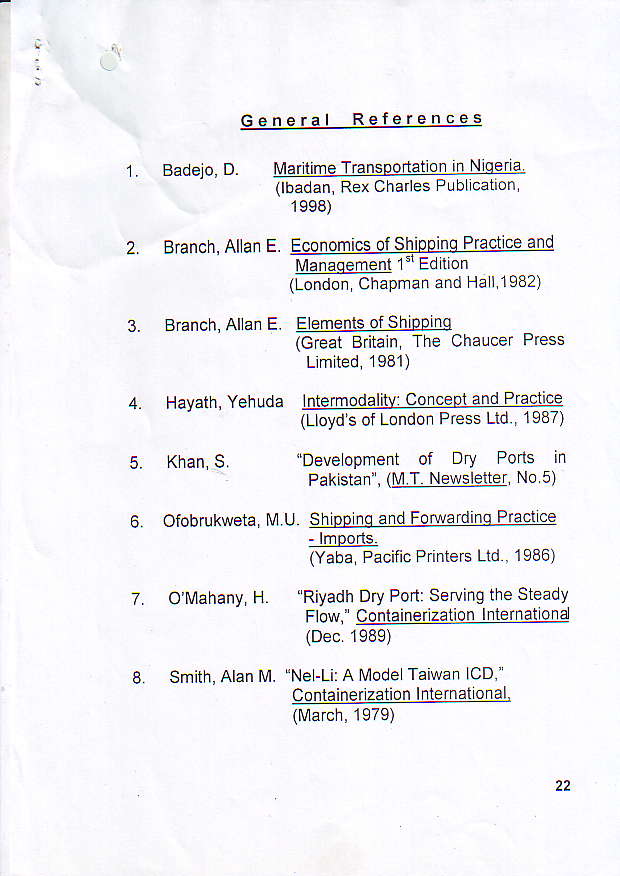
1.
Badeto
D.
llarltime
Transportauon
in Nloena
(lbadan,
Rex
Chanes
PubLcatron
1998)
2.
E. Ecoiornics
ofShippjno
PracUce
and
llanaoemenl
1" Ed lLon
(Londof
Chapman
and Ha I 1982)
3.
E. Elemenls
ofShLpoLnq
(Greai
Britaln
The Chalcer Press
Limted,1981)
lntermodalitv'
concepl
and
Practice
(Lloyds
of London
Ptess
Ltd 1987)
5. Khan,
S
"Deveopnent of Dry Porls in
Pakistan',
(l!lT Newsleiter.
No 5)
6
otobruhwerE
14u sh oo no and
Fod. drnq
Pr2d.e
(Yaba Pacific
Printers
L1d
. 1986)
7. o [,4ahany
H.
Riyadh
Dry Pori:
seruing
the Steadv
Flow,'
Containerlzation
lnlernatonzl
(Dec 1989)
'Ne
I
-Li:A l\\4ode
Taiwan
LCD.
Conlainerlzation
Internal
onal
iMarclr.
1979)
22
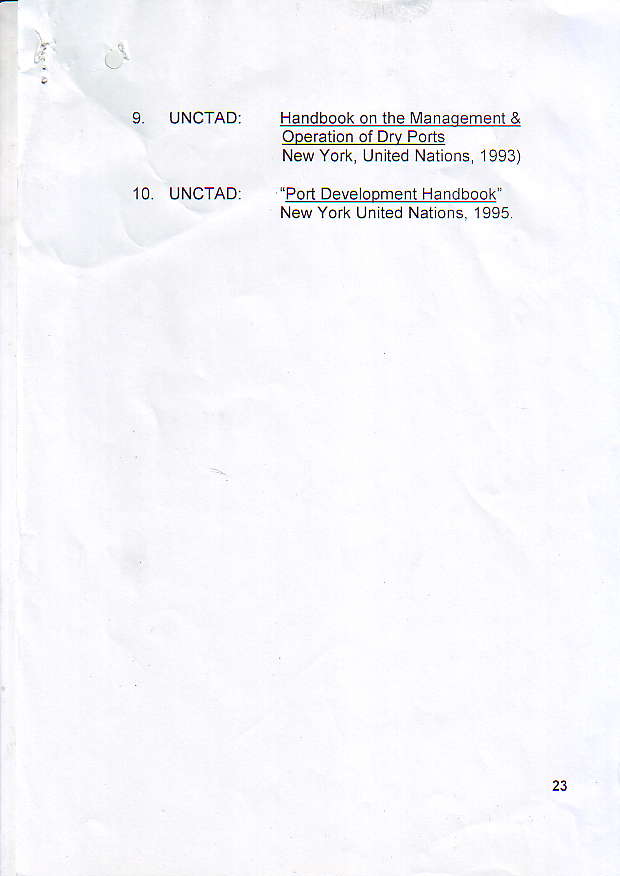
9. UNoIAD: &!d!.s9I_sdi.el&!.cse
Ooeration
of Drv Ports
New
York,
Unlled
Nations
1993)
10. UNCTAD:'eqd_49!919p49!!H3!!lb99!
New
York
United
NaUofs,
1995
